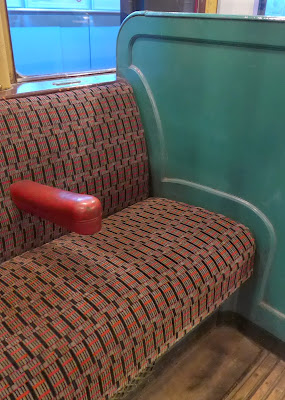Getting to know other bloggers and seeing what they're up to has been fun. It has been a great way of discovering new places to visit and things to see. A year ago I read about Prism's annual textiles exhibition on Gina's blog, Fan My Flame. Since then I've been keeping an eye out for this year's exhibition, Lines of Communication, at Hoxton Arches. I went today with a friend.
The work is all for sale. If we had the money what would we buy?
Despite this being so beautiful and delicate, I'm not sure I could put Tescos on my wall.
But that's the point, "a plastic bag can be more beautiful than its lowly origin".
We chatted about buying art, buying any of this work, taking it home. Can you buy a piece of art work because it goes with your sofa? What makes us choose?
Or perhaps put us off. Despite loving this train, why did we talk about having to dust it?
Sometimes, the work chooses you. It really did with this piece.
64 gloves, 64 monthly visits to see her mother with Alzheimers who hadn't recognised her for 10 years, 150 miles away.
"300 miles to sit and cry"
The slow deterioration of Alzheimers, strands of lost memories.
Not sure this piece is meant for a home, but it really should be in a permanent gallery.
There was something about the work that addressed mental health that touched us. We picked it out, it was work we would buy.
Or perhaps the pieces that seemed to simply play with textiles, colour, fibres and fabrics.
Made up of organza layered over satin, "Warp & Waft" really did. Waft in the breeze.
A sketchbook. I love sketchbooks.
Why is nice hand-writing so satisfying?
These textiles pieces did it for us, we might have to ditch the sofa.
I'll give Gina the last word.
There are only a few days left to "enjoy" this exhibition. It ends Sunday 31st May.
Lines of Communication, textile inspired art, Prism.
Hoxton Arches, Cremer Street, London, E2.
Details on the Prism website here.
These are just the pieces we picked out, there is so much more there.
























































